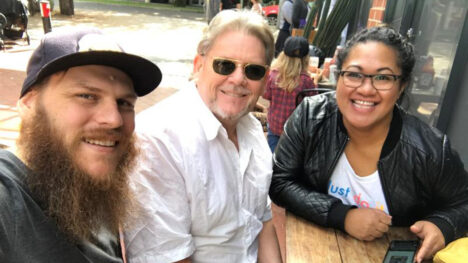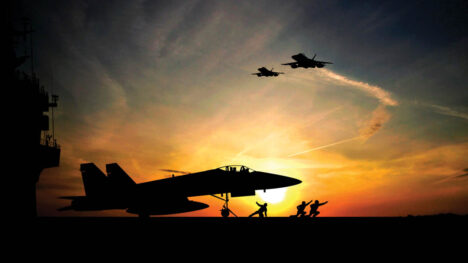My brother John and I grew up without a dad, yet we knew he was a hero. Mum told us boys that he had gone to war because—although 40 years old—he did not think it right that others should risk their lives in battle fighting for his family while he enjoyed the safety of Australia.
My father was born on October 31, 1900, in Ballyskeagh, not far from Belfast in North Ireland. Friends called him “Pat,” which is also the name he used for himself in his letters home from the front line. When he was 18, he joined the British Army and served his country in Palestine and India for four years.
Ready to leave Ireland, he settled his destiny in a typically Irish way—he flipped a coin. Heads, and he’d follow his brother William to Canada; tails, and he’d follow his sister Mary to Western Australia.
Tails it was, and thus he arrived at Fremantle in 1923.
For a while he worked on the wheat and sheep farm of his sister Mary and her husband, John Boyd, near Bruce Rock. However, he left there to make his fortune in the mining industry.
While working in rural WA, he fell in love with Jessie Jones, one of the domestic staff in the hotel. Soon they were married and set up home in Perth.
By the time Dad joined the AIF, two boys had been born, John in 1936 and Norman early in 1938. Only 10 per cent of AIF volunteers had children and most of them had only a single child. Most of the young men in Dad’s battalion were young bachelors. After four months training at the Northam (WA) army camp, Dad and his fellow troops were considered ready to be shipped out to the Middle East.
They were granted one week’s preembarkation leave from October 15 to 22, 1941. This did not include his 41st birthday on the 31st, so Dad corrected the army’s oversight by going absent without leave for the weekend of Friday, October 31, to Monday, November 3. He was caught on his return, and as a consequence lost his two Acting-Corporal stripes and was fined £1/7/0 (about $A2.70). They were scheduled to leave Northam on November 6, but Dad’s sixth wedding anniversary was on the 5th, so once again he took a couple of days off. He was back in time for an hour’s sleep before the first muster at 5am. All of Northam, it seemed, was at the station to wish the 1500 troops well as they boarded the train at 9:30pm and headed for Fremmantle.
As the train sped through Maylands station, his home station, Dad threw out of the window a note for Mum, which he had attatched to a stick. it landed at the feet of a young woman, who, along with many others, had gathered on the plaform – despite it being 3am. The young woman honoured Dad’s trust; she picked up the note a delivered it to his wife.
The were ferried out to the Queen Elizabeth and with the Queen mary and a naval escort they headed for Port Suez on the Red Sea side of the Suez Canal. His first letter from on board, written soon after they left Fremantle is full of emotion: “You are always telling how hard I am. Well, old darling, I don’t mind telling you now I had a funny lump in the throat tonight and tears were as close as they have been for years.”
By November 25, they were in their tents in Mughazi, Palestine, as members of the 24th Infantry Training Battalion, 28th Company. After two-and-a-half months training, a group of some 80 West Australians from th 24th Training Battalion joined the Victorian 2/5th battalion. Dad was one of these. By March 10, he was back at Port Suez boarding the SS Otranto with 3500 others headring for an unknown destination. Once well clear of Aden they were told they were to sail to Java.
The course was no sooner set than it was altetered. Java had fallen o the Japanese even before they left Port Suez. The new destination was Colombo, Ceylon (Sri Lanka). It was anticipated the Japanese would soon attack Ceylon; for whoever commanded its ports, controlled the Indian Ocean. The Japanese bombed Colombo with planes from their carrier fleet, but no invasion occured. After their arrival, Dad’s 2/5th Battalion was sent sounth to the port of Gallee. In Gallee they trained for jungle warfare, though their war games with each other were far short of the real thing.
Wth the Japanese thrat drawing nearer to Australia, the need to get the seasoned AID battalions home become urgent.On July 13, 1942, Dad, with some 4300 other troops, left Colombo harbour on board the Athlone Casle in convoy and headed for Autralia. While they were in transit Kokoda fell to the Japanese. Clearly they were needed closer to home. The Athlone Castle duly berthed in Melbourne on AUgust 4. The troops were given two week’ leae. The hundred or so West Australians in the 2/5th Battalion travelled home by train.
When leave was over they were shipped by train back to Melbourne, and then again by train to Greta Army Camp near Maitland (NSW) for more training. Two weeks later they were on their way to Brsbane, then to Milne Bay (Papua). From Brisbane, Dad wrote his last letter to Mum while on Autralian soil. It was full of apprehension: “Keep the chin up, darling, and say a little prayer for me. So now my own little pal and sweetheart I will have to say au revior to you now with all my love. Yours ever, Pat.”
The Dutch MS Maetsusycker, which the troops called “the mudsucker,” brought Dad and 860 to Milne Bay. Milne Bay was a malaria-infested quagire and though very fit, Dad, like so many ohers were hospitalised with fever. He wrote that if Mum sent him anything – make a pair of stilts. Only a month earlier that Australians had repulsed a Japanese amphibious attack that attempted to to capture the Allies’ airfields in the region.
The Japanese sent 3000 troups up the Salamaua road toward Wau in the New Guinea highlands, and were in sight of the airstrip when Headquaters decided to fly the whole 17th Brigade (which included Dad’s 2/5h Batallion) to repel the Japanese advance. The Japanese surprised the Autralians by using a diused German track that was unknown to the AIF leadership.
The Allies’ dominace of the air was the only factor that made the daring airlift of the 17 Brigade possible. The Australians began fighting within minutes of leaving the troop planes. “Defensive positions hurriedly occupied. A few words to put them into the picture and they were right into it.”
Flying conditions innto Wau were hazardous. Planes were turning around after only 20 to 30 minutes on the ground. Weather conditions were fickle and most days the cloud cover made landing impossible. Headquarters at Wau notified the leaders in Port Moresby “that i was essential they expedute arrival here of balance of 2/5 Batallion.” On January 27, 1943, they managed to land 90 oficers and 204 other ranks before the weather closed in and flying ceased for the day.
Six planes operated on January 28, which brought forth the message from the leaders in Wau that “flying conditions were perfect a Wau..what about more planes” By midday the perfect conditions had changed to “bad weather” and the flying ceased.
By the 29th the situation at the airstrip was desperate, but Port Moresby was “informed that Wau drome was still ours, the valley was open and they were requested to sent troops immediately.”
That morning “Japanese small arms and mortar fire from the south-east was beginning to fall on the outer defences of the airfield and continued intermittently until 0815.” Depsite this, by 1000 hours, six plans had landed, which received the response from Wau, “Thanks for troops, send more.” Throughout the 29th the weather was good and 60 transport planes arrived, which brought the rest of 2/5 Battalion including Dad’s D Company. That day 35 offivers and 580 other ranks of the 2/5th arrived at Wau.
Japanese snipers in the surrounding treets harassed the landing troops, but made no direct attack on the drome. Men who were wounded by sniper fire as they leapt from the Dakotas were sent back on the same plane that had brought them. The drome defence troops stayed at their posts for the whole night and fended of attacks. The 17th Brigade magazine describes the scene on the day of Dad’s arrival as “Vigorous patrolling. Clashes everywhere. Night falling on january 29. Once again in perimeter. Trigger fingers itchy. To move meant trouble.”
Just before dawn on the 30th, at least one regiment of Japanese made a concerted effort to take the airfield and pushed within 360 meteres of the drome’s perimeter. That day the 2/1st Field Regiment and their 25-pounder artillery arrived. Within two hours the 25 pounders were unloaded and assebmbled. Once they opened fire they inflicted tremendous damage on the Japanese. The Brigade’s War Diary gives a brief but blunt assessment: “250 Japs killed, regret no prisoners.” The Japanese retreated in the direction of Crystal Creek, a tributary of the Bulolo River.
With Wau drome secured, HQ was anxious that the Wau defenders go on the offensive and not allow the Japanese to escape. B and D Companies were to prepare to move out to clear the area west of the Bulolo River and south of the Little Wau and Big Wau creeks. At 10am on Febraury 5, Dad’s D Company (under Captain Dick MacFarlane) along with B Companu (under Captian Cam Bennett) moved out of the drome area toward Crystal Creek.
During their first Day, Dad’s D Company met no opposition and bivouacked that night on the west bank of the Bulolo River north-east of leahy’s Farm. Next morning they came up against entrenched Japanese headquarters’ area, and were “badly ambused.” Bennet’s men circled the Japanese wide through the jungle whilst Major A T Rowan’s A Company was brought up to hold the road from the front.
Meanwhile Dad’s D Company on the left side of the Crystal Creek road ran into a well-camouflaged defences and hot fire to which 10 fell. One of those was our father, Hugh “Pat” Young.
After 20 months in the AIF and only nine days in action, his military career had come to a sudden and tragic end. He had enlisted volunarily and – is- for us – still a hear. As Jess said, “Greater love has no-one than this, that he lay down his life for his friends [and family]” (John 15:13).
Of the 111 Wes Autralians who served in the 2/5th, only fiver were killed. Such is the lottery of war. The War Diary for February 6 is tense: “Casualties B Coy 2 killed 2 wounded. D Coy 5 killed 4 wounded.” The following two days saw further “savage and confused fighting” with more killed or wounded, including Captian MacFarlane, who was seriously wounded on the 7th. So many Japanese died in the Crystal Creek area (some 250-300) then it came to be called the “slaughterhouse.” There were widows and orphans created that day not opnly in the sunburnt country but also in the land of the rising sun.
In November 2000, on behalf of my brother and the grandchildren, it was my priviliage to bury Mum’s ashs at Dad’s graveside in the Law War Cemetery. Pastors Laurie Evans, Varrly Oliver and Brad Kemp led a simple but moving commital service. Dad and Mum’s wish to be together again was not fulfilled in the way they’d hoped and prayed for, but it brought some comfort to see thm rest together.








